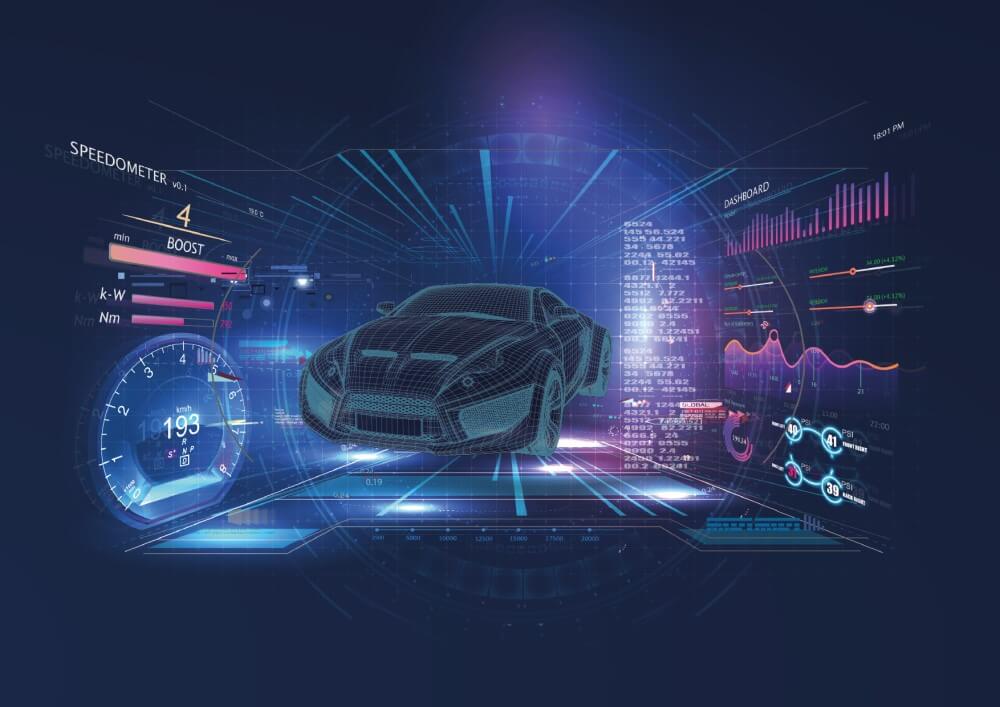What will the car of the future look like?

The car of the future is electrified, autonomous, shared and connected – welcome to the age of revolutionary change in the automotive industry.
To explore what the future holds for the concept of the car and how innovation is driving change, Business Leader and SETsquared, the global number one business incubator and enterprise partnership, gathered together a select group of academics, technology experts and scale-up business leaders for an in-depth roundtable debate.
The panel
- Dan Martin – Elmtronics
- Professor Liana Cipcigan – Cardiff University
- John Baker – Simply Do Ideas
- Auroskanda Vepari – IPFT Fuels
- William Hartley – Asirius
- Ralf Kernchen – Accelogress
- Charlie Alexander – Ultraleap
- Parvez Akhtar – Institute of Advanced Automotive Propulsion Systems, Bath University
- Florian Wagner – Clean Cold Power
- Jack Withinshaw – Airspeeder
- Colin Stakem – Sector Lead for Advanced Manufacturing, SETsquared Scale-Up Programme
In many ways, the acceleration of technological change in the automotive industry is being directed by environmental concerns. There is pressure to create a sustainable future with a transport system that creates no emissions and helps reduce congestion. In the UK, the Government has proposed new plans to ban the sale of petrol and diesel cars from 2035, and directives like these are quickening the evolution of cars powered by electricity.
For this to happen, a widespread infrastructure for electrification needs to be in place. During the debate, Dan Martin of Elmtronics, the UK’s largest independent supplier and installer of electric car chargers, explained the current situation:
He comments: “We’re starting to see a lot of private investment for electric charging points and we’re now over that tipping point, which was based on when electric cars (EVs) became a viable model. We’re now seeing a lot more EVs on the roads, hence why there’s now a growing number of charging stations available across the UK.
“This means you can drive from London to Newcastle in the very near future with complete confidence that you’re not going to run out of charge and get stuck anywhere. Trust in the electric infrastructure is certainly growing, we’re starting to see higher uptake from businesses operating with commercial fleets, as part of their commitment to sustainability.
“There’s still a lot of technological development needed but there’s increasing investment into charging technology and without the charging, electric and autonomous vehicles aren’t going to work.”
There is another form of electrification being developed which is built into our highway infrastructure. Professor Liana Cipcigan from Cardiff University is involved in the advancement of wireless dynamic charging on the road, in partnership with the National Grid:
She comments: “We’re working on decarbonising transport through electrification to create a transport hub, as part of an EPSRC Network+ project. It’s a whole system approach, with interconnected infrastructures requiring different transport sectors working together, including road, rail and aerospace. It’s difficult to solve the challenges involved with decarbonisation without forming integrated solutions.”
John Barker from Simply Do Ideas supports greater collaboration to solve the infrastructure challenge.
He says: “The prevalence of autonomous vehicles is reliant on the development of other supporting technologies and that’s everything from advanced battery technology, electrification through wireless charging and dynamic grid systems and the 5G network to run their connectivity.
“Collaborative solutions need to be found by joined-up thinking among diverse innovators working together digitally to drive interoperability, rather than leaving it to hopefully fit together like a jigsaw. I think this is a concern but also an opportunity for the industry.”
Auroskanda Vepari from IPFT Fuels is involved with the convergence of the utility sector and automotive technology in a project to develop dynamic grid charging:
His thoughts are as follows: “It’s a really interesting time. The supply chains involved have never interacted with each other and they think very differently, but they’re now coming in contact and working together in a way they’ve never done before. We’re focusing on efficiency and how to bring enhanced integration. The utility sector is a very low-margin business so we think efficiency will be the big driver.”
Regarding the future of the car, there is also a view that the innovation is evolving faster than the policy to oversee it.
“The UK is certainly near the front of vehicle-to-grid technology, but the regulations and incentives need to catch up so the technology and the policy can be married together,” said Russell Fenner from Hanger 19, which provides a chargepoint back office and supporting hardware and software solutions for EV and smart city markets.
“The ability to accelerate the technology needs to go in line with the regulations. We could really steam along and have perfect solutions in autonomy or vehicle-to-grid, but if the regulations make the business case harder, it’s trickier to get the extra investment because those people want to see that they’re going to get ROI before they support the technology.”
Regulation is a strong theme with regard to the safety of driverless cars. This is a well-documented ethical debate about autonomous vehicles (AVs) ‘playing God’ and how they will make valued judgements regarding human lives while on the road. William Hartley, Director of Asirius and an independent automotive consultant, said:
“The legislation for autonomous vehicles needs to be defined so that the software can be optimised for what’s acceptable in different scenarios. I think there’s a reticence about being the first government to decide; instead, they want to wait for someone else to do it first and see what happens before jumping on the bandwagon – which isn’t necessarily the best way to fill the world with autonomous cars! If you’re the first, you get the kudos of being first but if you’re first and it goes awry, you’ll always be the one who got it wrong.”
There is the race to get the charging infrastructure in place and we need governance for it and also for how AVs are going to behave, and this is a key part of convincing people that they are safe. The need to change mindsets is happening now. Many car manufacturers have massively invested in hybrids and electric cars, but there is a concern that the British public is not snapping them up.
“Leonardo DiCaprio bought a hybrid Toyota Prius in the 2000s and it made news headlines; everyone said he was an environmentalist saving the world,” said William Hartley.
“These days people are not perceived as geeks if they buy an electric car, they’re instead seen as leaders and revolutionaries who’re interested in driving exciting cars made by cutting-edge brands like Tesla. But people are still not willing to compromise on the convenience of petrol. Consumers are savvy enough to realise that going electric gives them performance, it’s clean, green and efficient BUT you can’t charge it in 5 minutes at a petrol station. This need for convenience is driving forward innovation for rapid-charging systems and advanced battery technology.
“The engine is no longer what sells a vehicle; the powertrain is just the inconvenience that happens to push the vehicle forward. The vehicle is really just a means to transport people in a way that they want to be transported, with an experience that they want to feel, and so the powertrain needs to become invisible in terms of size, cost, inefficiency and so on.
“The future is about the transportation experience. The mentality behind how a car is used needs to change; how to get people away from driving their car in the morning, driving it in the evening and the car just sitting in a car park all day and their driveway at night. Once there’s progression, you can then apply the driverless vehicles and the car sharing schemes to the world,” said William Hartley.
Car AI technology has also become more prevalent. Haptic alerts play a role in driver assistance and that kind of safety-inspired technology is becoming integral inside all new cars. Level 3 autonomous cars are already on sale, whereby the driver starts the journey and then takes their hands off the controls and relaxes into a more passenger experience. Ralf Kernchen from Accelogress, a UX Design coding business involved in transport software, said:
“I think progress with AI technology and its adoption isn’t as far ahead as hoped. As a result, the industry is concentrating on autonomous driving functions that people are more familiar with, like the autopilot from Tesla which introduces assistive auto driving for safety and convenience, and these interim measures will help smooth the transition to autonomy.”
Ultraleap is developing advanced cabin technology and is very much at the forefront of what is being developed for the car of the future. Charlie Alexander is from Ultraleap:
He says: “Why would you buy a Porsche when you can’t drive it? The question we’re posing to the premium automotive brands is how do you plan to differentiate yourself and enrich the travel experience? An obvious way is through providing richer media systems in the rear of the vehicle, where the passenger could interact with a 3D interactive film or receive video conferencing or engage with a 3D object where they can reach out, hold it, feel it and interact with it.
“There’s a huge advantage to being able to operate objects in midair, not by holding a wand or a joystick but actually by reaching out and holding an object which you can then feel, using our haptics technology, and then rotate and engage with it in the same way that you might in virtual reality. We can add associated technologies like holographic screens and augmented reality to create a truly connected experience.”
Today’s emerging share-centric transportation heralded by Uber is poised to alter vehicle ownership economics forever. Some reports estimate there will be more than 11 million shared driverless vehicles operating on the roads globally by 2030, serving an average of 64 users per shared vehicle.
Ralf Kernchen from Accelogress has been researching how to further support this future shared economy by designing solutions that make public transport more efficient:
He says: “Public transport is the most sustainable way to travel. What we’ve been working on is how to help people get out of their cars and onto public transport. For us this is developing apps that interconnect different modes of transport to provide real-time travel information, so people can plan their journey better and have a seamless user experience.”
At the heart of all of this development is the drive for zero emissions – but what technology can be developed in the meantime to act as a bridge between combustion engines and electrification? Parvez Akhtar from the Institute of Advanced Automotive Propulsion Systems (IAAPS) at the University of Bath has extensive knowledge of vehicle development:
“Right now, I’d like to see a semi-autonomy for conventional fossil fuel-powered vehicles that essentially controls the car’s ability to achieve better fuel economy and therefore less pollution. This would be another step in the right direction for zero-emissions and full Level 5 autonomy, which I can’t see coming within the next five years.”
Another way technology is supporting sustainable transportation is through reducing the impact of fleets on the environment. Florian Wagner from Clean Cold Power is developing refrigeration that is powered by air – without fossil fuels or air pollution:
He explains: “Refrigerated fleet operators have a substantial impact on the environment and there’s no ready-made solution that is affordable and practical to replace the use of diesel-powered refrigeration.
“Our refrigeration units are powered by sustainable nitrogen from the air and not only do they reduce emissions, they’re also quieter, reach cold temperatures faster, and have more precise cooling control than conventional systems.
“We’re offering our technology to supermarket chains and food producers and we also see our solution being used as air conditioning on buses and other forms of transportation,” said Florian Wagner.
So far, we have focused at ground level but there is a whole future for the car in the sky. Jack Withinshaw from Airspeeder, the world’s first electric flying car racing series, explains how the future of mobility can be forged through motorsport:
He says: “Flying cars is something that was promised for 2020 but they’re on the horizon. We expect it to be a $1.5 trillion industry by 2035 and there’s a lot of investment being pushed into this sector. Uber is leading the way and the early application is likely to be flying taxis. Toyota has invested about $600m into designing their flying autos and Daimler and Hyundai have also entered the sector. Those brands view their design as being about mobility rather than automotive.
“The reality is there’s a ton of regulatory issues on the ground, let alone in the air, and other hurdles to overcome relating to battery power, noise, certification and autonomy. But what we do with racing is a starting point; it’s a test bed and an opportunity to see this form of mobility in action.
“Formula E racing has progressed the technology behind electric cars, boosted public awareness and pushed electric car performance into a state of acceptance.
“Through racing, we can advance our mobility technology and ensure that after a few years, it is at its best state for public use.”
In summary
Many challenges lie ahead for the automotive industry – technological, industrial and legislative – but its transformation is well on the way and there is much opportunity for those able to support the transition.
SETsquared is establishing a network of ambitious companies in the automotive industry who want to scale-up and raise investment for their R&D. Colin Stakem, Sector Lead for Advanced Manufacturing from the SETSquared Scale-Up Programme:
“The Scale-up Programme is a partnership between the universities of Bath, Bristol, Cardiff, Exeter, Southampton and Surrey and it offers funded support to help develop collaborative R&D bids. It starts with a series of one-day innovation workshops to enable SMEs to further enhance their business model and establish relationships with our university partners.
“The Scale-Up Programme is linked to an investor network and we have an online platform of investors, which forges links to individual projects. Throughout the year, we organise investor showcase events to give innovative SMEs the opportunity to meet and pitch to investors. This is further supported through a series of focused networking opportunities at industry events with leading speakers.”




